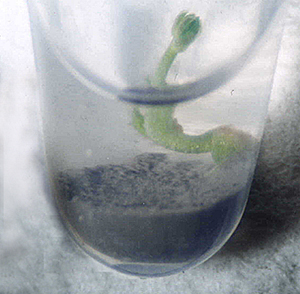The Interstellar Panspermia Society: Dedicated to securing and expanding life in space through directed panspermia.
Life is unique in Nature, and for us, it is precious. It is unique in its complex patterns, and in its purposeful self-continuation. Humans are a part of life and we share its drive for self-propagation. Being a part of life then implies a human purpose to secure, expand and propagate our family of gene/protein life.
This purpose is best achieved in space, where the life that we plant can have an immense future. We can start now to secure this future, by seeding new solar systems with microbial representatives of our gene/protein family of life. New species can then develop there, some into intelligent beings who will further expand life in the galaxy. Securing that future can give our human existence a cosmic purpose. More here
 |
Space is fertile: Plant seedlings growing on asteroid/meteorite soil |
Science and Technology:
Rapid advances in astronomy, space science and biology will make directed panspermia possible in this century. These advances are occurring in many related areas.Target selection:
Directed panspermia will target extra-solar planetary systems, nine of which are already known to have habitable planets, and many more are expected. We can also reach clusters of newly forming planetary systems in interstellar clouds, where local life would not have yet started. more hereLaunch and Propulsion:
Micron-thick solar sails can launch interstellar spaceships, or swarms of capsules, filled with microbes toward new solar systems at interstellar speeds over 0.0001 times the speed of light. more hereNavigation:
Precise astrometry can aim the missions to the targets at their positions in the future when the missions arrive. Large interstellar clouds can be targeted easily.more hereCapture and Survival:
The microbial capsules may be first captured in asteroids and comets, and then delivered to planets. Astroecology experiments with meteorites showed that microorganisms and plants can survive at the targets on these asteroid and cometary materials.more hereMicrobiology:
Mixtures of microorganisms suited to new environments should be selected, including cyanobacteria, extremophiles that can survive under various extreme conditions, and hardy small multicellular rotifers and tardigrades that will speed-jump higher evolution. more hereCosmoecology:
Cosmology predicts that the galaxy will remain habitable for abundant life, that can advance for trillions of eons. Intelligent life will then understand Nature more deeply, and seek to extend life to eternity.link to to the paper Mautner, Michael N. (2005), "Life in the Cosmological Future: Resources, Biomass and Populations", Journal of the British Interplanetary Society 58: 167–180Apart from this website, the scientific basis and ethical motivation to secure and expand life in space are presented in the popular-science book “Seeding the Universe with Life: Securing Our Cosmological Future” (see book link below)
FAQ
Why Now?- Life on Earth is already vulnerable, and it will end when the Sun ends.
- We shall soon be able to launch panspermia missions to secure the future of life, but we don’t know how much longer our space-faring civilization may last to do so.
- Therefore it is prudent to secure the future of life while we can.
Will we disturb endemic life?
- There is no scientific evidence that extraterrestrial life exists. Still, we should only target new solar systems where life would not have emerged yet.
- Directed panspermia missions will secure life in hundreds of new worlds, but still leave billions of stars in the galaxy intact.
- When the sun explodes, life on Earth will certainly end, and if we are alone, so will all life. We cannot risk the future of all life for the sake of extraterrestrials who may not even exist.
- If we are alone, the future of life is in our hands. We belong to gene-protein organic life, and our first responsibility is to secure and advance our own family of life.
Is Life finite?
- Cosmology predicts a habitable universe that can harbor immense life for trillions of eons. Life may then come to control Nature, and our remote descendants may seek to extend life to eternity. We must assure that life will be there to do so.
The book: the scientific basis and ethical motivation to secure and expand life in space are presented in the popular-science book: “Seeding the Universe with Life: Securing Our Cosmological Future”.
The book can be downloaded for free (pdf) here, or a hardcopy can be ordered at www.amazon.com
The whole scientific document: "Directed Panspermia: Strategies and Motivation for Seeding Star-Forming Clouds", M.Mautner, Journal of the British Interplanetary Society 1997, 50, 93-102, can be downloaded (pdf): here
Or use the links in the drop down menus above to come to those sections that interest.



